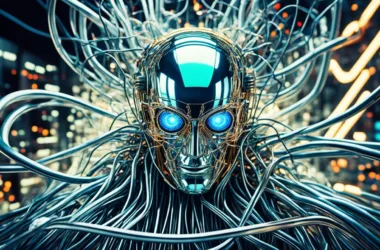Starting your journey to become a machine learning engineer is thrilling for today’s developers. AI for software development is becoming a must-have, not just a trend. By learning machine learning in software engineering, you can unlock new opportunities for innovation and efficiency.
This guide gives you a plan that boosts your skills and adds powerful machine learning techniques. With this plan, you can move forward in mastering AI and machine learning with confidence.
It doesn’t matter if you’re new to code or have years of experience. Becoming a machine learning engineer requires gaining specific skills. With carefully chosen resources, you can grow your knowledge of machine learning’s principles and practices.
Key Takeaways
- Identify the essential path to transitioning from software development to machine learning engineering.
- Understand the significance of AI in modern software development workflows.
- Acquire a structured plan to incorporate machine learning techniques into your skillset.
- Discover resources that pave the way for informed learning and application of ML principles.
- Recognize the importance of continuous learning to thrive as a machine learning engineer.
Why Machine Learning Is Essential for Modern Software Development
Machine learning and AI (Artificial Intelligence) are changing software development. They change how we build and care for systems. This knowledge helps developers grow and solve problems in new ways. It encourages a change from old ways of programming.
The Evolution of Programming with ML/AI Technologies
Adding machine learning and AI to software development marks a big step in programming’s growth. These technologies bring in smart algorithms that learn and adjust on their own. This opens the door to smarter, more efficient systems.
Machine Learning’s Impact on Industry and Innovation
Machine learning is leading innovation in fields like healthcare and finance. It automates complex tasks and makes systems that predict what users and markets will do. This makes ML very important in today’s online world.
Marc Andreessen’s Vision and the Machine Learning Paradigm Shift
Marc Andreessen once said that “software is eating the world.” This matches today’s trend of machine learning ruling the scene. This big change to smarter, data-based apps shows how ML is changing software engineering.
Understanding the Machine Learning Landscape
The ML landscape is vast and complex. It offers challenges and chances for those who make software. To succeed, knowing the machine learning taxonomy and ML models is crucial. This knowledge helps builders make strong machine learning solutions. It also helps them make smart decisions with data.
At the heart of navigating this field is understanding how ML models work. They process and understand huge data sets to predict or complete tasks. As these models get more complex, developers need a deep understanding of machine learning. They must grasp several key areas:
- Classification of ML Models: Knowing the differences between supervised, unsupervised, and reinforcement learning is key. It helps choose the best method for certain problems.
- Algorithm Performance: It’s important to know how data presentation affects algorithm performance. This helps make ML models better.
- Quality of Data: Good data is essential for effective machine learning systems. It shows why it’s important to collect and process data well.
Leveraging these elements in development requires a good grip on the ML landscape. This includes tech skills and a strategy mindset. One must understand how machine learning can impact real-life situations.
By getting to know the machine learning taxonomy, developers can improve. They can make more adaptable and efficient ML models. This boosts their abilities. It also makes them important players in tech’s evolution across fields.
Practical Applications of Machine Learning in Software Projects
Adding machine learning to software projects has hugely grown ML practical applications. It shows big improvements across different industries. Developers learn a lot about ML’s wide impact by looking at various machine learning use cases.
Machine Learning Use Cases in Varied Fields
Machine learning works in many areas, solving hard problems:
- Predictive maintenance in manufacturing helps see machine problems before they happen. This reduces downtime and keeps machines running longer.
- In healthcare, ML helps look through a lot of data to diagnose diseases, leading to better patient care.
- Financial services use ML for smarter trading, credit scoring, and tailored financial advice. This improves how they help customers and their efficiency.
From Fraud Detection to Advanced Natural Language Processing
ML is especially strong in fraud detection and natural language processing:
- For fraud detection, ML spots odd patterns that could mean fraud. This helps protect personal and money info.
- Advanced natural language processing changes how we interact. It allows for harder tasks like translating languages, figuring out people’s feelings, and automatic customer service.
Key Concepts in Machine Learning for Developers
Developers stepping into machine learning must grasp ML concepts and AI programming principles. These basics are practical tools that improve the work of ML algorithms in the real world.
Let’s start with the importance of data representation. It’s a key part that affects the success of machine learning models. Methods like TF-IDF or word2vec change raw data into a format machines can understand. This boosts the models’ ability to learn.
- Data Representation Techniques: Learn to show data effectively with TF-IDF and word2vec models.
- Algorithmic Implementation: Use AI programming principles to turn these data presentations into workable algorithms.
Additionally, challenging existing mental models and trying new ways to solve problems can create stronger ML solutions. It’s about rethinking tools and methods to address complex issues better. This is key to moving from beginner to expert in machine learning.
- Question and explore current ML models and algorithms for innovation.
- Apply advanced ML concepts to improve these models for better performance and accuracy.
In conclusion, excelling in machine learning requires deep understanding of ML concepts and AI programming principles. Focus on data representation quality and be ready to innovate. This approach helps create effective and transformative ML algorithms.
Data: The Fuel for Machine Learning Engines
In the world of machine learning, data is everything. It’s not just a starting point but the main ingredient that keeps the system running. Machine learning data acquisition and strong data processing tools are key. They help create models that are both accurate and can grow. This part talks about how important it is to gather and use data right for machine learning.
Acquiring and Understanding Your Dataset
For any machine learning model to work well, it needs good data. Getting this data means finding the right sources and making sure it’s top-quality and relevant. It’s about either using existing data places or making new datasets that fit what you need. The goal is to deeply understand this data so your project does what you want.
Tools and Techniques for Efficient Data Handling
After getting the data, you need to manage it well. We use advanced data processing tools for this. Tools like Apache Spark, Flink, and Airflow change the game in handling data. They let us deal with big amounts quickly and as things happen. These tools make the job easier and help developers find important points in big datasets.
- Apache Spark: Ideal for handling batch and real-time data processing.
- Flink: Excels in providing real-time analytics and event-driven applications.
- Airflow: Helps in scheduling and monitoring workflows efficiently.
Each tool has its own special features for different machine learning projects. They make sure data is not just there but is being used smartly for making good decisions.
Becoming a Machine Learning Engineer: Skills and Tools
Starting a career in machine learning requires solid ML engineer skills and knowledge of various ML tools. Success in this field comes from strong programming skills and understanding math well.
Knowing programming languages like Python and R is crucial. They are key for writing good code and for complex ML algorithms. It’s also important to know algorithms, probability, and statistics well to model and interpret data effectively.
- Algorithms: Essential for problem-solving within software contexts.
- Probability and Statistics: Crucial for making predictions and decisions based on data.
Knowing ML tools and frameworks is also key. TensorFlow is a popular framework that makes creating and training ML models easy. Learning to use tools like Scikit-learn and Keras will also help in building better ML systems.
- TensorFlow: Facilitates the development and training of ML models with its flexible and comprehensive toolkit.
- Scikit-learn: Ideal for implementing classical machine learning algorithms efficiently.
- Keras: Enables fast experimentation with deep neural networks, accelerating the concept-to-product process.
Continually learning and applying knowledge are key to improving ML engineer skills. Learning from real projects and constantly refining processes and models makes top engineers stand out.
To succeed as a machine learning engineer, one must keep learning and mastering new skills. This dynamic field requires staying up to date with ML tools and tech. It’s about creating innovative, effective, and efficient solutions to complex problems.
Navigating the Machine Learning Development Process
The journey through the ML development process can be tricky for both newbies and experts. It starts with a simple machine learning project setup and ends with deploying working ML models. Each step needs careful planning and a strategic approach.
Setting Up Your First Machine Learning Project
Starting your first ML project needs a good base in theory and hands-on skills. Knowing the tools and setups for machine learning project setups is key. Developers should start by:
- Identifying the problem statement: Clearly defining what the project aims to resolve.
- Selecting appropriate data sets: This is critical as the quality and type of data will dictate the project’s outcome.
- Choosing the right algorithms and tools: Depending on the project requirements, selecting suitable models and frameworks.
- Setting up a development environment: Configuring the workspace with necessary software and APIs.
Model Development to Deployment: An Overview
The path from model development to deployment includes several key steps in the ML development process. These steps are:
- Model Training: Using historical data to train your ML model until it reaches desired accuracy.
- Model Evaluation: Assessing the model with new data to test its efficacy and making adjustments as needed.
- Deployment: Integrating the model into a production environment where it can start delivering real business value.
- Monitoring and Maintenance: Continuously tracking model performance to fix any issues and improve results over time.
In these phases, developers must ensure all system parts work together well. Using strong data storage, powerful servers, and creating scalable systems is key to making an ML model work.
Knowing these parts and mastering the ML development process helps both new and expert developers. They can not only start their first machine learning project setup but also handle many ML projects well.
Future Trends: The Ongoing Evolution of ML in Software Development
The rapid machine learning evolution is changing software development big time. Looking into the ML future trends, we see technology moving fast. This forces developers to always be learning and growing.
As machine learning grows in the development field, several key areas become important:
- More machine learning use in areas usually based on set rules shows a move to adaptable, data-led app designs.
- Improvement of machine learning algorithms boosts what applications can do by themselves, pushing limits further.
- Regular updates in ML frameworks and APIs make adding advanced data analysis to projects easier.
This serpentine journey of machine learning evolution does more than change tools. It totally changes how problems are solved in software development. Developers need to keep up with these changes to stay ahead and be creative in the tech world.
In summary, the direction of ML future trends is making machine learning more central in creating new software. This highlights how crucial it is for tech pros to keep learning and adapting.
Conclusion
The journey into machine learning for a software developer is exciting and tough. It needs a deep love for AI’s power and its future role in AI development. Developers learn about machine learning’s power to change industries and personal growth from mastering it. This career puts you at the edge of tech innovation, where your work makes a big impact.
Learning key skills and tools is essential in this complex field. As AI moves forward, the demand for skilled machine learning engineers grows. Staying dedicated to learning and seeking knowledge drives this journey. It’s full of chances and big discoveries. By keeping a mindset of constant learning and applying what they learn, developers can tap into machine learning’s vast potential. They can make a special place for themselves in this exciting field.
The future of AI calls to those ready to explore machine learning’s details. There’s always a need for new, smart solutions in a world leaning more on intelligent systems. A strong career in machine learning is incredibly valuable. As technology’s story goes on, committing to this path is more than a job choice. It’s a way to help build a future where human creativity and AI bring endless opportunities.






